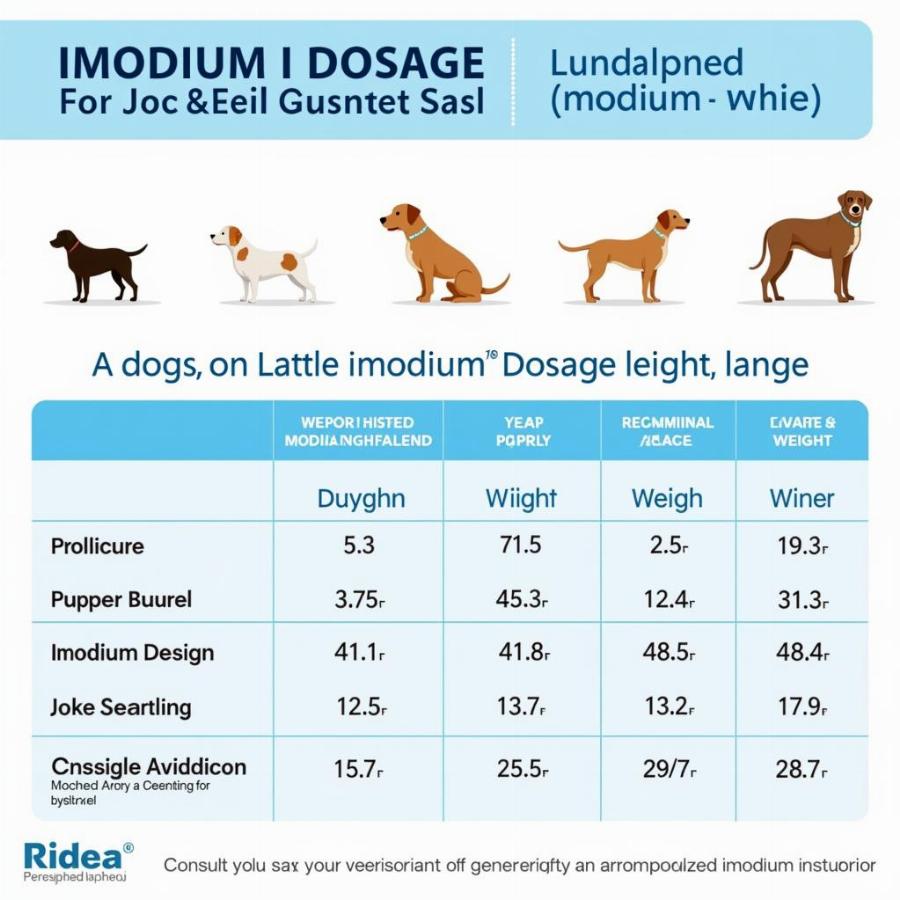Knowing the correct Imodium dosage for dogs can be a lifesaver when your furry friend is experiencing diarrhea. However, it’s crucial to remember that Imodium is not a one-size-fits-all solution and should only be administered under the guidance of a veterinarian.
This comprehensive guide will provide you with all the information you need about using Imodium for dogs, including a handy Imodium dosage chart, potential side effects, and when it’s time to seek immediate veterinary care.
Understanding Imodium and its Use in Dogs
Imodium, known generically as loperamide, is an over-the-counter medication primarily used to treat diarrhea in humans. It works by slowing down the movement of the intestines, which helps reduce the frequency and urgency of bowel movements.
While not specifically approved for veterinary use, Imodium is sometimes recommended by vets for dogs experiencing diarrhea due to:
- Stress or anxiety: Just like us, dogs can experience digestive upset when stressed, such as during travel or vet visits.
- Dietary indiscretions: Eating something they shouldn’t, like garbage or table scraps, can lead to diarrhea in dogs.
- Sudden changes in diet: Switching your dog’s food abruptly can upset their stomach and cause diarrhea.
Imodium Dosage for Dogs by Weight Chart
It is crucial to consult with your veterinarian before giving your dog any medication, including Imodium. The correct dosage can vary depending on the underlying cause of the diarrhea, your dog’s age, health condition, and other factors.
However, a general guideline for Imodium dosage in dogs based on weight is as follows:
| Weight Range (lbs) | Liquid Imodium (1 mg/7.5 ml) |
|---|---|
| Under 10 | Consult your vet |
| 10-20 | 0.5 ml – 1 ml |
| 21-30 | 1 ml – 1.5 ml |
| 31-40 | 1.5 ml – 2 ml |
| 41-50 | 2 ml – 2.5 ml |
| Over 50 | Consult your vet |
Note: This chart is for informational purposes only and should not be used as a substitute for professional veterinary advice.
 Imodium Dosage Chart for Dogs
Imodium Dosage Chart for Dogs
How to Administer Imodium to Your Dog
Imodium for dogs typically comes in liquid form. You can administer it directly into your dog’s mouth using a syringe (without the needle) or mix it with their food. If mixing it with food, ensure your dog consumes the entire portion to receive the full dose.
When to Contact Your Veterinarian
While Imodium can be helpful in some cases of diarrhea, it’s essential to monitor your dog closely after administration. Contact your veterinarian immediately if:
- Your dog’s diarrhea doesn’t improve within 24-48 hours.
- The diarrhea worsens or is accompanied by other symptoms like vomiting, lethargy, loss of appetite, bloody stool, or abdominal pain.
- You notice any signs of an allergic reaction, such as facial swelling, hives, or difficulty breathing.
Important Considerations
“Never self-diagnose or self-treat your dog’s diarrhea,” advises Dr. Emily Parker, a veterinarian with over 15 years of experience. “While Imodium might seem like a quick fix, it’s crucial to identify the underlying cause to ensure your furry friend receives the appropriate treatment.”
When Imodium is NOT Safe for Dogs
Certain breeds, such as collies, sheepdogs, and Australian shepherds, are genetically predisposed to a sensitivity to certain drugs, including Imodium. Additionally, avoid giving Imodium to:
- Puppies under six months of age
- Pregnant or nursing dogs
- Dogs with certain medical conditions such as liver disease, kidney disease, or hypothyroidism
Beyond Imodium: Supporting Your Dog’s Recovery
In addition to administering the correct Imodium dosage, there are other steps you can take to support your dog’s recovery from diarrhea:
- Withhold food for 12-24 hours: This allows their digestive system to rest and recover.
- Provide plenty of fresh water: Diarrhea can lead to dehydration, so it’s crucial to ensure your dog stays hydrated.
- Introduce a bland diet: Once you reintroduce food, start with small, frequent meals of boiled chicken and rice or other bland options recommended by your vet.
FAQs: Imodium for Dogs
1. Can I give my dog Imodium for vomiting?
Imodium is not effective for treating vomiting in dogs. If your dog is vomiting, consult your veterinarian for appropriate treatment.
2. How long does it take for Imodium to work in dogs?
Imodium usually starts working within 1-2 hours after administration.
3. What are the potential side effects of Imodium in dogs?
While generally safe when used as directed by a veterinarian, potential side effects of Imodium in dogs can include constipation, lethargy, loss of appetite, and in rare cases, more serious reactions.
4. Can I crush Imodium tablets for my dog?
While you can crush Imodium tablets, it’s best to use the liquid form for easier and more accurate dosing.
5. My dog ate something toxic; can I give him Imodium?
No, do not give Imodium if you suspect your dog has ingested something toxic. Contact your veterinarian or the ASPCA Animal Poison Control Center (888-426-4435) immediately.
Keep Your Canine Companion Healthy and Happy
Diarrhea is a common ailment in dogs, and knowing the correct Imodium dosage can be helpful in providing relief. However, it’s vital to consult your veterinarian before administering any medication to your furry friend. By working together, you can ensure your dog receives the best possible care for a swift and comfortable recovery.
About Beaut Dogs
Beaut Dogs is your trusted resource for all things related to our canine companions. We provide expert advice, helpful tips, and the latest information to help you provide the best possible care for your furry friend. For personalized guidance on Imodium dosage for your dog, please contact our team of experts at [email protected]. We are here to support you and your beloved pet every step of the way.